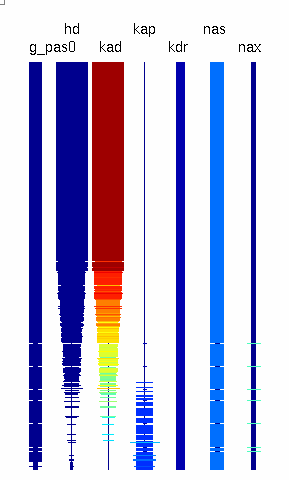This is the readme for the NQS method presented in the paper:
Lytton WW (2006) Neural Query System: Data-mining from within the
NEURON simulator. Neuroinformatics 4:163-76
The following sequence will populate the NQS database with information
from one of the models in ModelDB. In the following I downloaded
model 44050 from ModelDB
http://senselab.med.yale.edu/senselab/ModelDB/ShowModel.asp?model=44050
'CA1 pyramidal neuron: dendritic spike initiation, Gasparini et al
2004' This gave me a zip file named modeldb.zip which is included for
convenience in this NQS archive.
unzip NQS_with_MFP_and_model.zip
// includes MFP and modeldb.zip (model accession number 44050, 2007-09-26)
cp NQS/vecst.mod modeldb
cd modeldb
nrnivmodl
setenv HOC_LIBRARY_PATH ../NQS:../MFP
// run special; close native graphics
nrngui forfig5A.hoc
load_file("setup.hoc")
load_file("mechs.hoc")
trunc(nq,nq2) // create the shape databases
// At this point you may wish to explore the databases by looking at
various NQS commands; eg
nq.gets() // show the headers
nq.pr(10) // show the first 10 entries
nq2.gets() // show the headers
nq2.pr(10) // show the first 10 entries
mechnqs(nq2) // add in the conductance densities
// Now the conductances have been added to nq2; look again
nq2.gets() // show the headers
nq2.pr(10) // show the first 10 entries
nrfp() // will graph out the conductance densities; graph may need
// to be translated and resized
Then hopefully you will see a result similar to fig 1 from the paper
but for the Gaspirini et al. model:
 Note that some models may be far more complicated to load, having
several different subdirectories with mod files, hoc files and
templates. In such cases, it is necessary to find your way around
these directories before using shape.hoc. In general, it will be
necessary to recompile the model with vecst.mod included by moving
vecst.mod to the directory with other mod files and then reexecuting
'nrnivmodl.' The resulting 'special' can then be run as before with
nrngui and shape.hoc can be loaded with a load_file() command.
Some models may cause failures when loading shape.hoc. This will
occur when the underlying model to be tested defines something as an
object reference or as a number that is then used differently in
shape.hoc. For example, shape.hoc defines a procedure p_p(). If an
underlying model executed eg 'objref p_p' or 'p_p=7.2' then an error
will occur when loading shape.hoc (This problem occurs because I have
not encapsulated shape.hoc in a template so as to protect its
variables.)
Changelog
---------
2022-05: Updated MOD files to contain valid C++ and be compatible
with the upcoming versions 8.2 and 9.0 of NEURON.
Note that some models may be far more complicated to load, having
several different subdirectories with mod files, hoc files and
templates. In such cases, it is necessary to find your way around
these directories before using shape.hoc. In general, it will be
necessary to recompile the model with vecst.mod included by moving
vecst.mod to the directory with other mod files and then reexecuting
'nrnivmodl.' The resulting 'special' can then be run as before with
nrngui and shape.hoc can be loaded with a load_file() command.
Some models may cause failures when loading shape.hoc. This will
occur when the underlying model to be tested defines something as an
object reference or as a number that is then used differently in
shape.hoc. For example, shape.hoc defines a procedure p_p(). If an
underlying model executed eg 'objref p_p' or 'p_p=7.2' then an error
will occur when loading shape.hoc (This problem occurs because I have
not encapsulated shape.hoc in a template so as to protect its
variables.)
Changelog
---------
2022-05: Updated MOD files to contain valid C++ and be compatible
with the upcoming versions 8.2 and 9.0 of NEURON.
 Note that some models may be far more complicated to load, having
several different subdirectories with mod files, hoc files and
templates. In such cases, it is necessary to find your way around
these directories before using shape.hoc. In general, it will be
necessary to recompile the model with vecst.mod included by moving
vecst.mod to the directory with other mod files and then reexecuting
'nrnivmodl.' The resulting 'special' can then be run as before with
nrngui and shape.hoc can be loaded with a load_file() command.
Some models may cause failures when loading shape.hoc. This will
occur when the underlying model to be tested defines something as an
object reference or as a number that is then used differently in
shape.hoc. For example, shape.hoc defines a procedure p_p(). If an
underlying model executed eg 'objref p_p' or 'p_p=7.2' then an error
will occur when loading shape.hoc (This problem occurs because I have
not encapsulated shape.hoc in a template so as to protect its
variables.)
Changelog
---------
2022-05: Updated MOD files to contain valid C++ and be compatible
with the upcoming versions 8.2 and 9.0 of NEURON.
Note that some models may be far more complicated to load, having
several different subdirectories with mod files, hoc files and
templates. In such cases, it is necessary to find your way around
these directories before using shape.hoc. In general, it will be
necessary to recompile the model with vecst.mod included by moving
vecst.mod to the directory with other mod files and then reexecuting
'nrnivmodl.' The resulting 'special' can then be run as before with
nrngui and shape.hoc can be loaded with a load_file() command.
Some models may cause failures when loading shape.hoc. This will
occur when the underlying model to be tested defines something as an
object reference or as a number that is then used differently in
shape.hoc. For example, shape.hoc defines a procedure p_p(). If an
underlying model executed eg 'objref p_p' or 'p_p=7.2' then an error
will occur when loading shape.hoc (This problem occurs because I have
not encapsulated shape.hoc in a template so as to protect its
variables.)
Changelog
---------
2022-05: Updated MOD files to contain valid C++ and be compatible
with the upcoming versions 8.2 and 9.0 of NEURON.